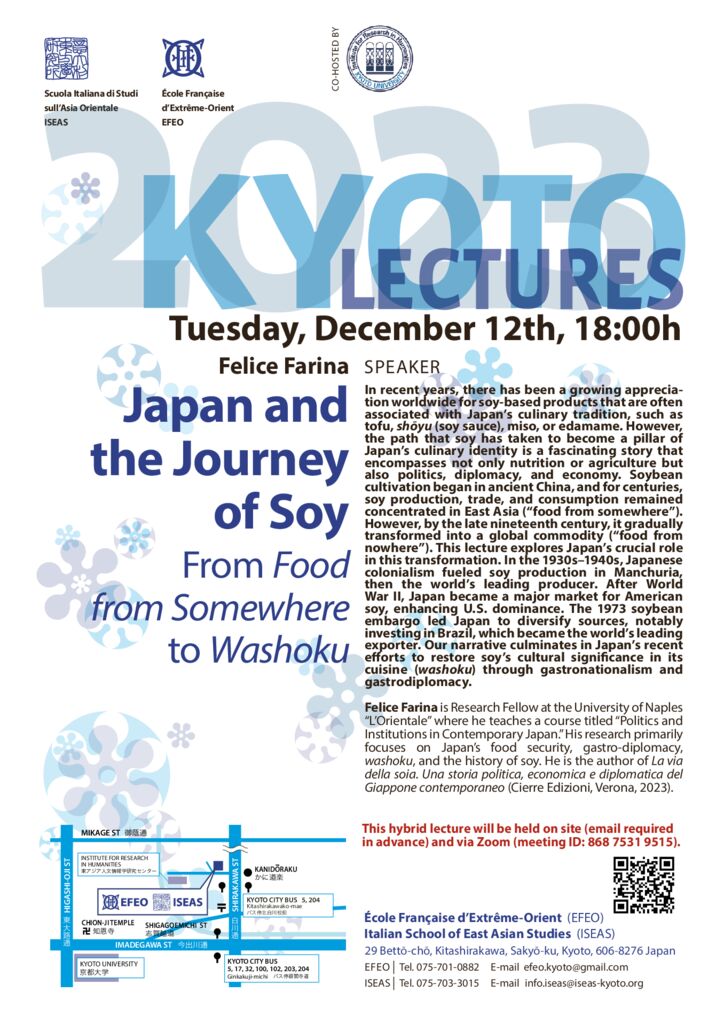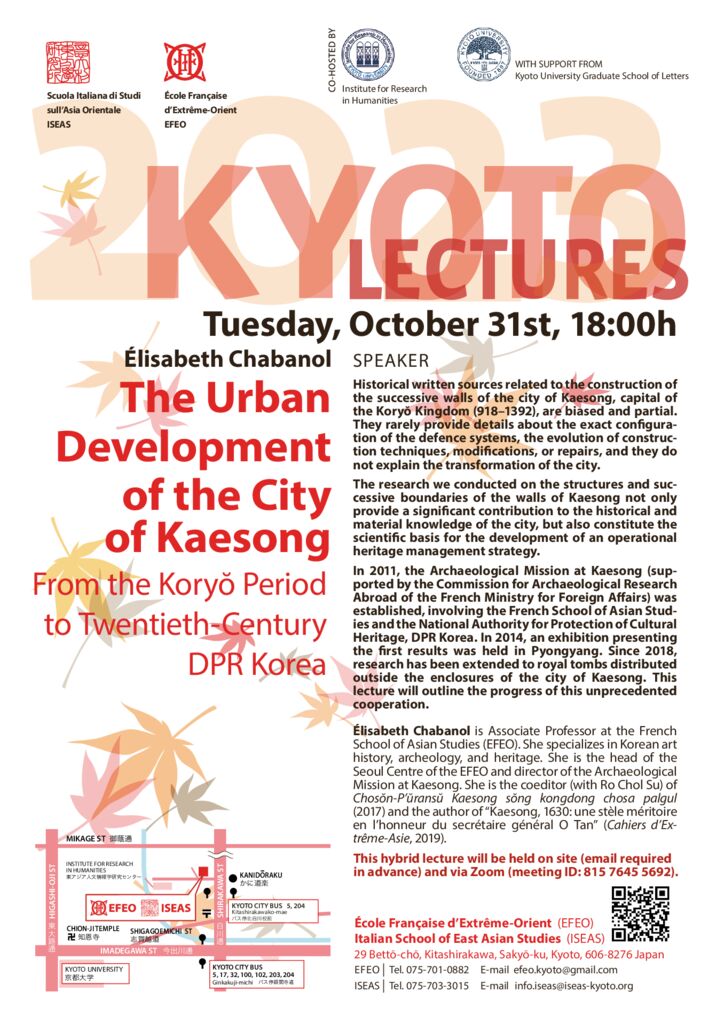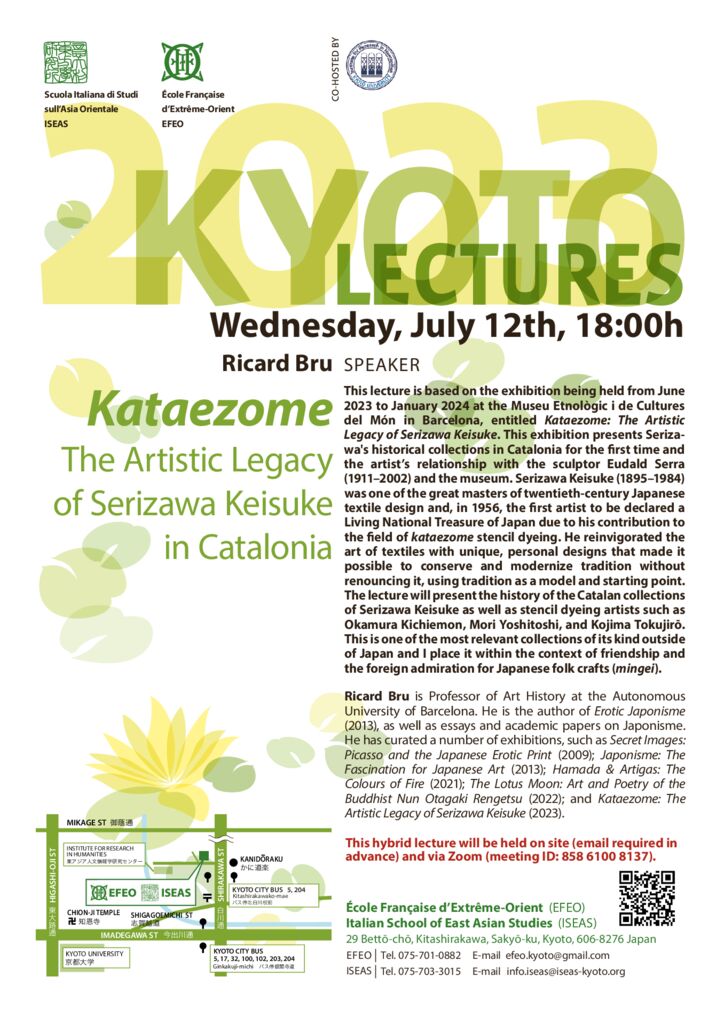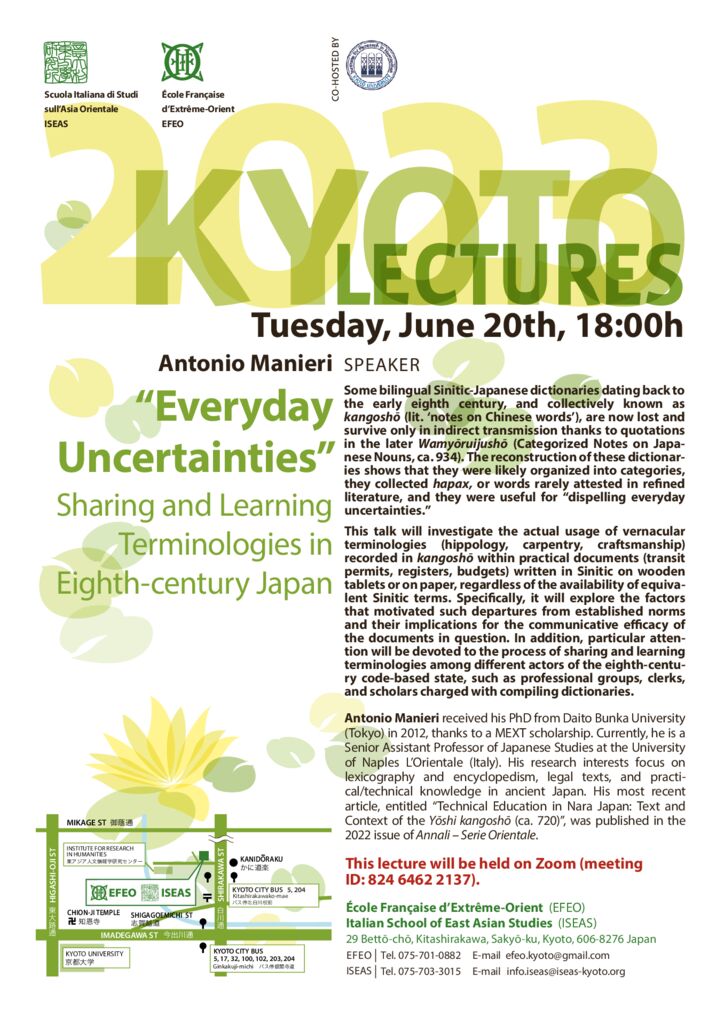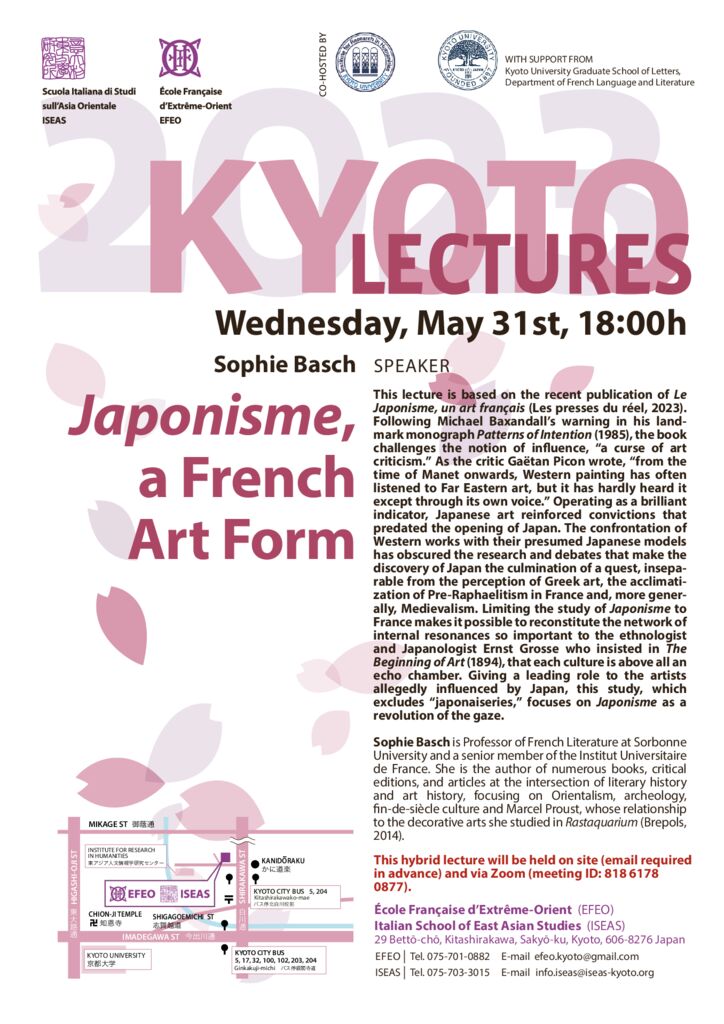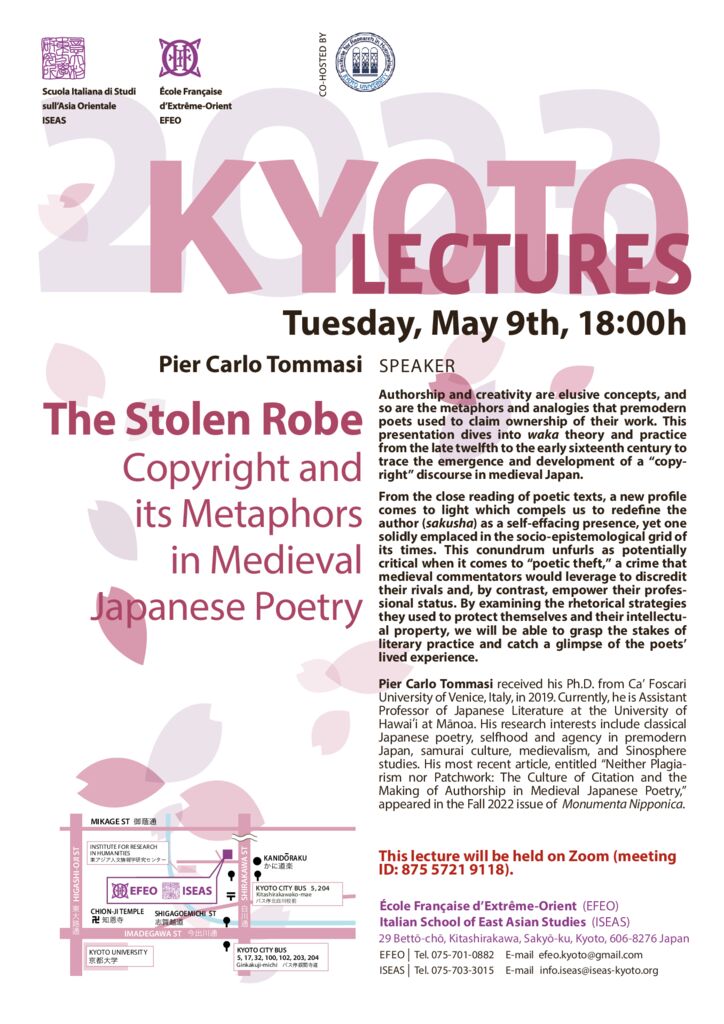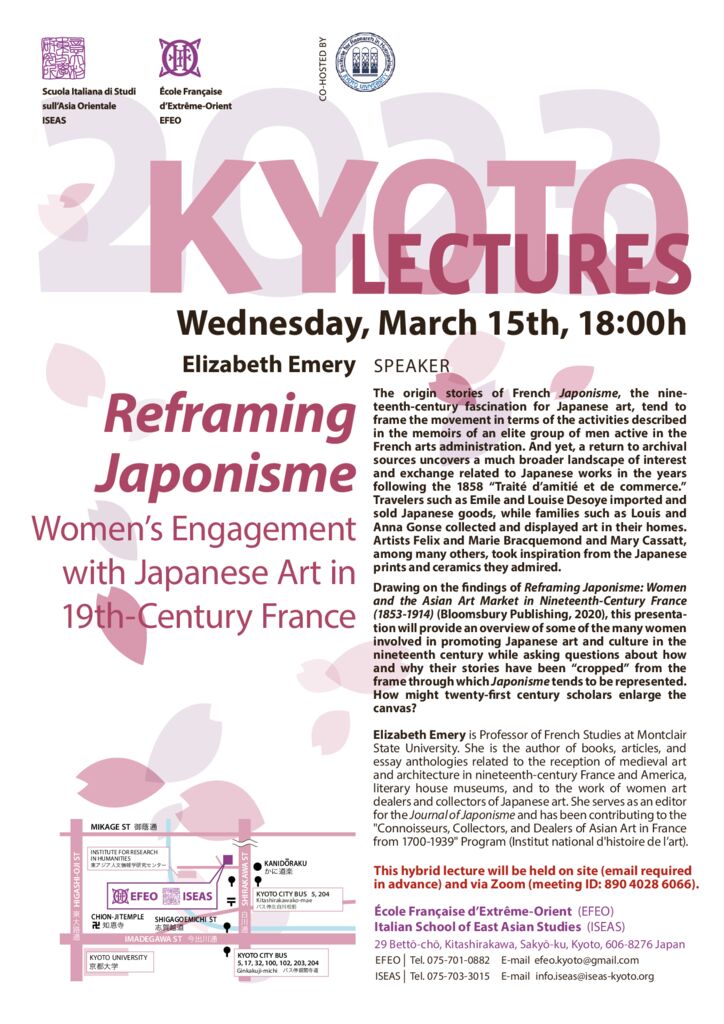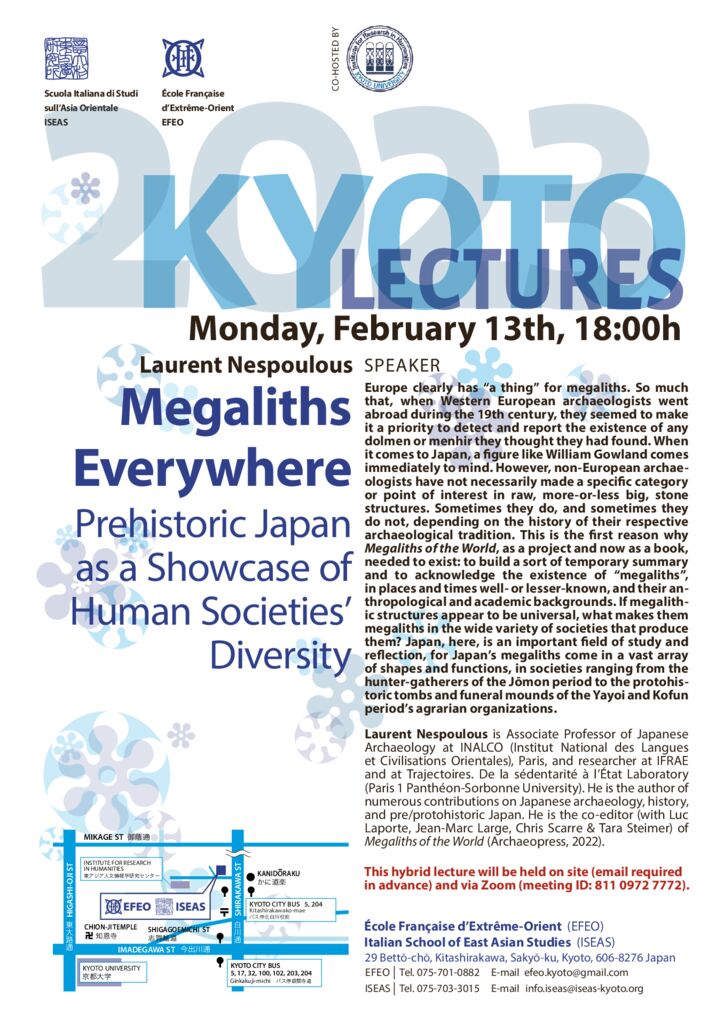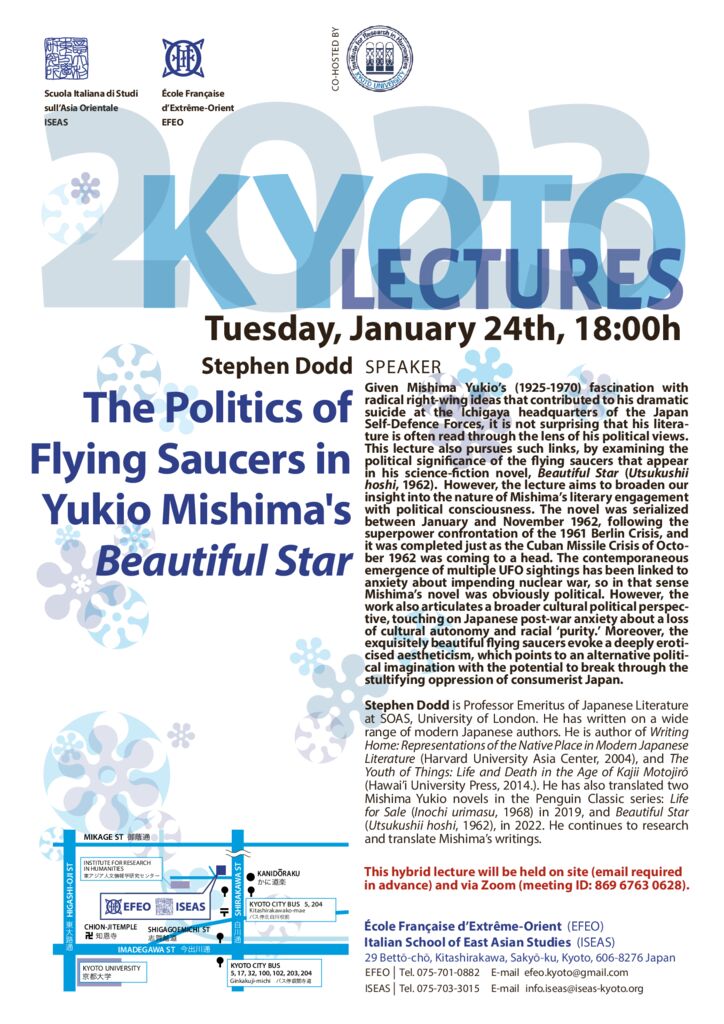Kyoto Lectures
Japan and the Journey of Soy
From Food from Somewhere to Washoku
Felice Farina
December 12th, 2023 18:00
This lecture will be held on site and via Zoom
In recent years, there has been a growing appreciation worldwide for soy-based products that are often associated with Japan’s culinary tradition, such as tofu, shōyu (soy sauce), miso, or edamame. However, the path that soy has taken to become a pillar of Japan’s culinary identity is a fascinating story that encompasses not only nutrition or agriculture but also politics, diplomacy, and economy. Soybean cultivation began in ancient China, and for centuries, soy production, trade, and consumption remained concentrated in East Asia (“food from somewhere”). However, by the late nineteenth century, it gradually transformed into a global commodity (“food from nowhere”). This lecture explores Japan’s crucial role in this transformation. In the 1930s–1940s, Japanese colonialism fueled soy production in Manchuria, then the world’s leading producer. After World War II, Japan became a major market for American soy, enhancing U.S. dominance. The 1973 soybean embargo led Japan to diversify sources, notably investing in Brazil, which became the world’s leading exporter. Our narrative culminates in Japan’s recent efforts to restore soy’s cultural significance in its cuisine (washoku) through gastronationalism and gastrodiplomacy.
Felice Farina is Research Fellow at the University of Naples “L’Orientale” where he teaches a course titled “Politics and Institutions in Contemporary Japan.” His research primarily focuses on Japan’s food security, gastro-diplomacy, washoku, and the history of soy. He is the author of La via della soia. Una storia politica, economica e diplomatica del Giappone contemporaneo (Cierre Edizioni, Verona, 2023).
This hybrid lecture will be held on site (email required in advance) and via Zoom (meeting ID: 868 7531 9515).
The meeting link will remain posted on the ISEAS website top page from December 10.
Kyoto Lectures
“Hokusai”
The Name that Sold Books
Ellis Tinios
November 22nd, 2023 18:00
This lecture will be held on site and via Zoom
The Hokusai ‘brand’ in book illustration was the product of astute marketing, wilful misrepresentation, blatant plagiarism and great art. Titles illustrated by Katsushika Hokusai (1760–1849) such as Hokusai manga and Fugaku hyakkei were the hottest property in art book publishing in 19th-century Japan. Hokusai also illustrated novels, poetry anthologies and educational texts. Some publishers even reissued books illustrated by his pupils in his name. No other Japanese artist produced as rich, varied and powerful a corpus of images for reproduction in book format as Hokusai. The books of few other Japanese artists were disseminated as widely as his. Art books assumed a major role in the formation of Hokusai’s reputation in his lifetime; posthumously they played a significant role in his recognition and appreciation abroad. His book illustrations attracted notice in Europe and North America well before his colour woodblock prints or paintings. After the latter became more widely known, interest in his books did not abate. It is, therefore, appropriate to characterise the Hokusai oeuvre in book form as a highly marketable brand, one that has been eagerly consumed by a global audience.
Ellis Tinios taught East Asian History at the University of Leeds. He has participated in research projects at the School of Oriental & African Studies, Cambridge University, the British Museum and the Art Research Center at Ritsumeikan University. He has taught courses on the book in early modern Japan in the USA under auspices of the Rare Book School. His research has encompassed the materiality of the book, erotic books, and books illustrated by Maruyama-Shijō artists, and Hokusai’s books.
This hybrid lecture will be held on site (email required in advance) and via Zoom (meeting ID: 848 7771 2839).
The meeting link will remain posted on the ISEAS website top page from November 20.
Kyoto Lectures
The Urban Development of the City of Kaesong
From the Koryŏ Period to Twentieth-Century DPR Korea
Élisabeth Chabanol
October 31st, 2023 18:00
This lecture will be held on site and via Zoom
Historical written sources related to the construction of the successive walls of the city of Kaesong, capital of the Koryŏ Kingdom (918–1392), are biased and partial. They rarely provide details about the exact configuration of the defence systems, the evolution of construction techniques, modifications, or repairs, and they do not explain the transformation of the city.
The research we conducted on the structures and successive boundaries of the walls of Kaesong not only provide a significant contribution to the historical and material knowledge of the city, but also constitute the scientific basis for the development of an operational heritage management strategy.
In 2011, the Archaeological Mission at Kaesong (supported by the Commission for Archaeological Research Abroad of the French Ministry for Foreign Affairs) was established, involving the French School of Asian Studies and the National Authority for Protection of Cultural Heritage, DPR Korea. In 2014, an exhibition presenting the first results was held in Pyongyang. Since 2018, research has been extended to royal tombs distributed outside the enclosures of the city of Kaesong. This lecture will outline the progress of this unprecedented cooperation.
Élisabeth Chabanol is Associate Professor at the French School of Asian Studies (EFEO). She specializes in Korean art history, archeology, and heritage. She is the head of the Seoul Centre of the EFEO and director of the Archaeological Mission at Kaesong. She is the coeditor (with Ro Chol Su) of Chosŏn-P’ŭransŭ Kaesong sŏng kongdong chosa palgul (2017) and the author of “Kaesong, 1630: une stèle méritoire en l’honneur du secrétaire général O Tan” (Cahiers d’Extrême-Asie, 2019).
This hybrid lecture will be held on site (email required in advance) and via Zoom (meeting ID: 815 7645 5692).
The meeting link will remain posted on the ISEAS website top page from October 29.
Kyoto Lectures
Kataezome
The Artistic Legacy of Serizawa Keisuke in Catalonia
Ricard Bru
July 12th, 2023 18:00
This lecture will be held on site and via Zoom
This lecture is based on the exhibition being held from June 2023 to January 2024 at the Museu Etnològic i de Cultures del Món in Barcelona, entitled Kataezome: The Artistic Legacy of Serizawa Keisuke. This exhibition presents Serizawa’s historical collections in Catalonia for the rst time and the artist’s relationship with the sculptor Eudald Serra (1911–2002) and the museum. Serizawa Keisuke (1895–1984) was one of the great masters of twentieth-century Japanese textile design and, in 1956, the rst artist to be declared a Living National Treasure of Japan due to his contribution to the eld of kataezome stencil dyeing. He reinvigorated the art of textiles with unique, personal designs that made it possible to conserve and modernize tradition without renouncing it, using tradition as a model and starting point. The lecture will present the history of the Catalan collections of Serizawa Keisuke as well as stencil dyeing artists such as Okamura Kichiemon, Mori Yoshitoshi, and Kojima Tokujiro. This is one of the most relevant collections of its kind outside of Japan and I place it within the context of friendship and the foreign admiration for Japanese folk crafts (mingei).
Ricard Bru is Professor of Art History at the Autonomous University of Barcelona. He is the author of Erotic Japonisme (2013), as well as essays and academic papers on Japonisme. He has curated a number of exhibitions, such as Secret Images: Picasso and the Japanese Erotic Print (2009); Japonisme: The Fascination for Japanese Art (2013); Hamada & Artigas: The Colours of Fire (2021); The Lotus Moon: Art and Poetry of the Buddhist Nun Otagaki Rengetsu (2022); and Kataezome: The Artistic Legacy of Serizawa Keisuke (2023).
This hybrid lecture will be held on site (email required in advance) and via Zoom (meeting ID: 858 6100 8137).
The meeting link will remain posted on the ISEAS website top page from July 10.
Kyoto Lectures
“Everyday Uncertainties”
Sharing and Learning Terminologies in Eighth-century Japan
Antonio Manieri
June 20th, 2023 18:00
This lecture will be available only on Zoom
Some bilingual Sinitic-Japanese dictionaries dating back to the early eighth century, and collectively known as kangoshō (lit. ‘notes on Chinese words’), are now lost and survive only in indirect transmission thanks to quotations in the later Wamyōruijushō (Categorized Notes on Japanese Nouns, ca. 934). The reconstruction of these dictionaries shows that they were likely organized into categories, they collected hapax, or words rarely attested in refined literature, and they were useful for “dispelling everyday uncertainties.”
This talk will investigate the actual usage of vernacular terminologies (hippology, carpentry, craftsmanship) recorded in kangoshō within practical documents (transit permits, registers, budgets) written in Sinitic on wooden tablets or on paper, regardless of the availability of equivalent Sinitic terms. Specifically, it will explore the factors that motivated such departures from established norms and their implications for the communicative efficacy of the documents in question. In addition, particular attention will be devoted to the process of sharing and learning terminologies among different actors of the eighth-century code-based state, such as professional groups, clerks, and scholars charged with compiling dictionaries.
Antonio Manieri received his PhD from Daito Bunka University (Tokyo) in 2012, thanks to a MEXT scholarship. Currently, he is a Senior Assistant Professor of Japanese Studies at the University of Naples L’Orientale (Italy). His research interests focus on lexicography and encyclopedism, legal texts, and practical/technical knowledge in ancient Japan. His most recent article, entitled “Technical Education in Nara Japan: Text and Context of the Yōshi kangoshō (ca. 720)”, was published in the 2022 issue of Annali – Serie Orientale.
Zoom meeting ID: 824 6462 2137
The meeting link will remain posted on the ISEAS website top page from June 18.
Kyoto Lectures
Japonisme, a French Art Form
Sophie Basch
May 31st, 2023 18:00
This lecture will be held on site and via Zoom
This lecture is based on the recent publication of Le Japonisme, un art français (Les presses du réel, 2023). Following Michael Baxandall’s warning in his landmark monograph Patterns of Intention (1985), the book challenges the notion of inuence, “a curse of art criticism.” As the critic Gaëtan Picon wrote, “from the time of Manet onwards, Western painting has often listened to Far Eastern art, but it has hardly heard it except through its own voice.” Operating as a brilliant indicator, Japanese art reinforced convictions that predated the opening of Japan. The confrontation of Western works with their presumed Japanese models has obscured the research and debates that make the discovery of Japan the culmination of a quest, inseparable from the perception of Greek art, the acclimatization of Pre-Raphaelitism in France and, more generally, Medievalism. Limiting the study of Japonisme to France makes it possible to reconstitute the network of internal resonances so important to the ethnologist and Japanologist Ernst Grosse who insisted in The Beginning of Art (1894), that each culture is above all an echo chamber. Giving a leading role to the artists allegedly inuenced by Japan, this study, which excludes “japonaiseries,” focuses on Japonisme as a revolution of the gaze.
Sophie Basch is Professor of French Literature at Sorbonne University and a senior member of the Institut Universitaire de France. She is the author of numerous books, critical editions, and articles at the intersection of literary history and art history, focusing on Orientalism, archeology, n-de-siècle culture and Marcel Proust, whose relationship to the decorative arts she studied in Rastaquarium (Brepols, 2014).
This hybrid lecture will be held on site (email required in advance) and via Zoom (meeting ID: 818 6178 0877).
The meeting link will remain posted on the ISEAS website top page from may 29.
Kyoto Lectures
The Stolen Robe
Copyright and its Metaphors in Medieval Japanese Poetry
Pier Carlo Tommasi
May 9th, 2023 18:00
This lecture will be available only on Zoom
Authorship and creativity are elusive concepts, and so are the metaphors and analogies that premodern poets used to claim ownership of their work. This presentation dives into waka theory and practice from the late twelfth to the early sixteenth century to trace the emergence and development of a “copyright” discourse in medieval Japan.
From the close reading of poetic texts, a new profile comes to light which compels us to redefine the author (sakusha) as a self-effacing presence, yet one solidly emplaced in the socio-epistemological grid of its times. This conundrum unfurls as potentially critical when it comes to “poetic theft,” a crime that medieval commentators would leverage to discredit their rivals and, by contrast, empower their professional status. By examining the rhetorical strategies they used to protect themselves and their intellectual property, we will be able to grasp the stakes of literary practice and catch a glimpse of the poets’ lived experience.
Pier Carlo Tommasi received his Ph.D. from Ca’ Foscari University of Venice, Italy, in 2019. Currently, he is Assistant Professor of Japanese Literature at the University of Hawaiʻi at Mānoa. His research interests include classical Japanese poetry, selfhood and agency in premodern Japan, samurai culture, medievalism, and Sinosphere studies. His most recent article, entitled “Neither Plagiarism nor Patchwork: The Culture of Citation and the Making of Authorship in Medieval Japanese Poetry,” appeared in the Fall 2022 issue of Monumenta Nipponica.
Zoom meeting ID: 875 5721 9118
The meeting link will remain posted on the ISEAS website top page from may 7.
Kyoto Lectures
Reframing Japonisme
Women’s Engagement with Japanese Art in 19th-Century France
Elizabeth Emery
March 15th, 2023 18:00
This lecture will be held on site and via Zoom
The origin stories of French Japonisme, the nineteenth-century fascination for Japanese art, tend to frame the movement in terms of the activities described in the memoirs of an elite group of men active in the French arts administration. And yet, a return to archival sources uncovers a much broader landscape of interest and exchange related to Japanese works in the years following the 1858 “Traité d’amitié et de commerce.” Travelers such as Emile and Louise Desoye imported and sold Japanese goods, while families such as Louis and Anna Gonse collected and displayed art in their homes. Artists Felix and Marie Bracquemond and Mary Cassatt, among many others, took inspiration from the Japanese prints and ceramics they admired.
Drawing on the findings of Reframing Japonisme: Women and the Asian Art Market in Nineteenth-Century France (1853-1914) (Bloomsbury Publishing, 2020), this presentation will provide an overview of some of the many women involved in promoting Japanese art and culture in the nineteenth century while asking questions about how and why their stories have been “cropped” from the frame through which Japonisme tends to be represented. How might twenty-first century scholars enlarge the canvas?
Elizabeth Emery is Professor of French Studies at Montclair State University. She is the author of books, articles, and essay anthologies related to the reception of medieval art and architecture in nineteenth-century France and America, literary house museums, and to the work of women art dealers and collectors of Japanese art. She serves as an editor for the Journal of Japonisme and has been contributing to the “Connoisseurs, Collectors, and Dealers of Asian Art in France from 1700-1939” Program (Institut national de l’histoire de l’art).
This hybrid lecture will be held on site (email required in advance) and via Zoom (meeting ID: 890 4028 6066).
Kyoto Lectures
Megaliths Everywhere
Prehistoric Japan as a showcase of human societies’ diversity
Laurent Nespoulous
February 13th, 2023 18:00
This lecture will be held on site and via Zoom
Europe clearly has “a thing” for megaliths. So much that, when Western European archaeologists went abroad during the 19th century, they seemed to make it a priority to detect and report the existence of any dolmen or menhir they thought they had found. When it comes to Japan, a figure like William Gowland comes immediately to mind. However, non-European archaeologists have not necessarily made a specific category or point of interest in raw, more-or-less big, stone structures. Sometimes they do, and sometimes they do not, depending on the history of their respective archaeological tradition. This is the first reason why Megaliths of the World, as a project and now as a book, needed to exist: to build a sort of temporary summary and to acknowledge the existence of “megaliths”, in places and times well- or lesser-known, and their anthropological and academic backgrounds. If megalithic structures appear to be universal, what makes them megaliths in the wide variety of societies that produce them? Japan, here, is an important field of study and reflection, for Japan’s megaliths come in a vast array of shapes and functions, in societies ranging from the hunter-gatherers of the Jōmon period to the protohistoric tombs and funeral mounds of the Yayoi and Kofun period’s agrarian organizations.
Laurent Nespoulous is Associate Professor of Japanese Archaeology at INALCO (Institut National des Langues et Civilisations Orientales), Paris, and researcher at IFRAE and at Trajectoires. De la sédentarité à l’État Laboratory (Paris 1 Panthéon-Sorbonne University). He is the author of numerous contributions on Japanese archaeology, history, and pre/protohistoric Japan. He is the co-editor (with Luc Laporte, Jean-Marc Large, Chris Scarre & Tara Steimer) of Megaliths of the World (Archaeopress, 2022).
This hybrid lecture will be held on site (email required in advance) and via Zoom (meeting ID: 811 0972 7772).
Kyoto Lectures
The Politics of Flying Saucers in Yukio Mishima’s Beautiful Star
Stephen Dodd
January 24th, 2023 18:00
This lecture will be held on site and via Zoom
Given Mishima Yukio’s (1925-1970) fascination with radical right-wing ideas that contributed to his dramatic suicide at the Ichigaya headquarters of the Japan Self-Defence Forces, it is not surprising that his literature is often read through the lens of his political views. This lecture also pursues such links, by examining the political significance of the flying saucers that appear in his science-fiction novel, Beautiful Star (Utsukushii hoshi, 1962). However, the lecture aims to broaden our insight into the nature of Mishima’s literary engagement with political consciousness. The novel was serialized between January and November 1962, following the superpower confrontation of the 1961 Berlin Crisis, and it was completed just as the Cuban Missile Crisis of October 1962 was coming to a head. The contemporaneous emergence of multiple UFO sightings has been linked to anxiety about impending nuclear war, so in that sense Mishima’s novel was obviously political. However, the work also articulates a broader cultural political perspective, touching on Japanese post-war anxiety about a loss of cultural autonomy and racial ‘purity.’ Moreover, the exquisitely beautiful flying saucers evoke a deeply eroticised aestheticism, which points to an alternative political imagination with the potential to break through the stultifying oppression of consumerist Japan.
Stephen Dodd is Professor Emeritus of Japanese Literature at SOAS, University of London. He has written on a wide range of modern Japanese authors. He is author of Writing Home: Representations of the Native Place in Modern Japanese Literature (Harvard University Asia Center, 2004), and The Youth of Things: Life and Death in the Age of Kajii Motojirō (Hawai’i University Press, 2014.). He has also translated two Mishima Yukio novels in the Penguin Classic series: Life for Sale (Inochi urimasu, 1968) in 2019, and Beautiful Star (Utsukushii hoshi, 1962), in 2022. He continues to research and translate Mishima’s writings.
This hybrid lecture will be held on site (email required in advance) and via Zoom (meeting ID: 869 6763 0628).
